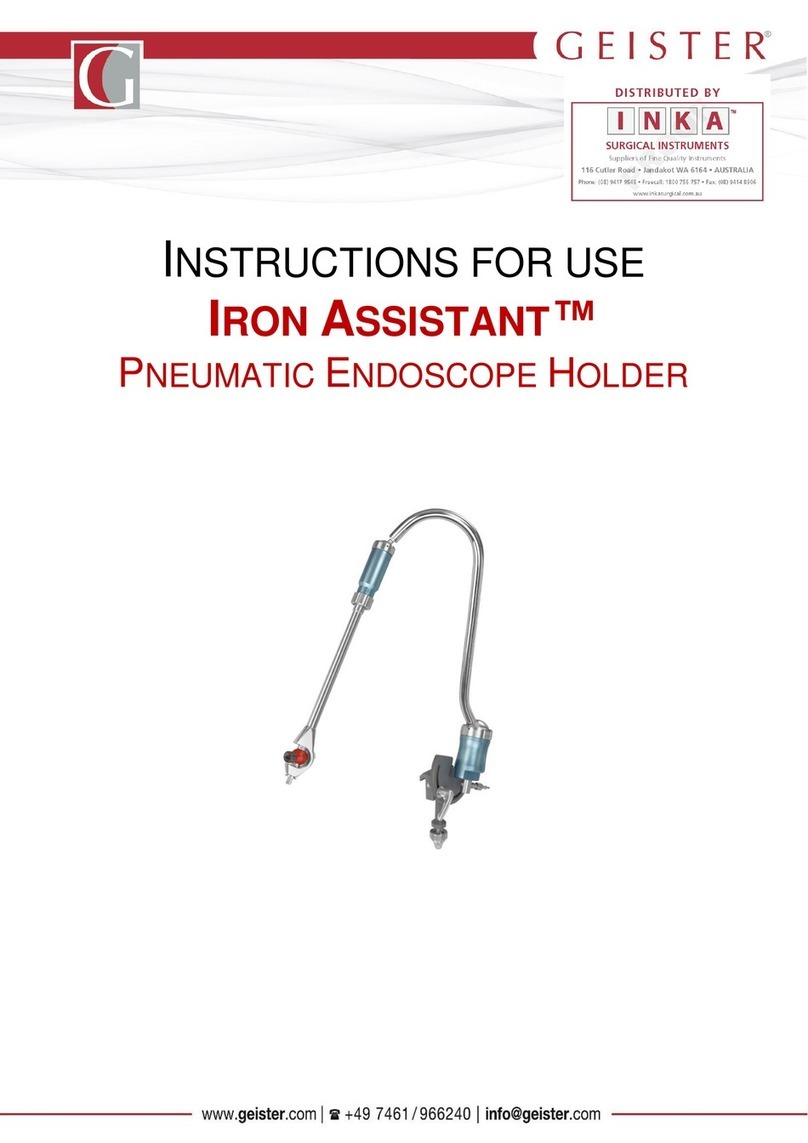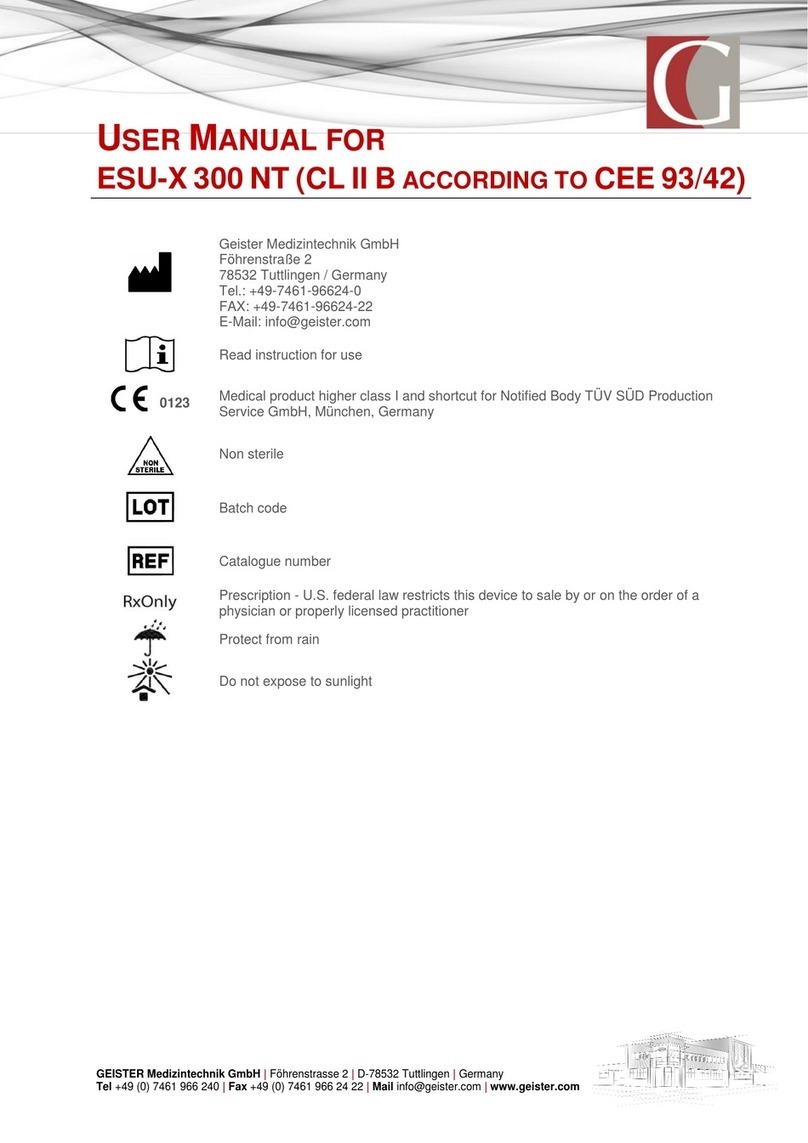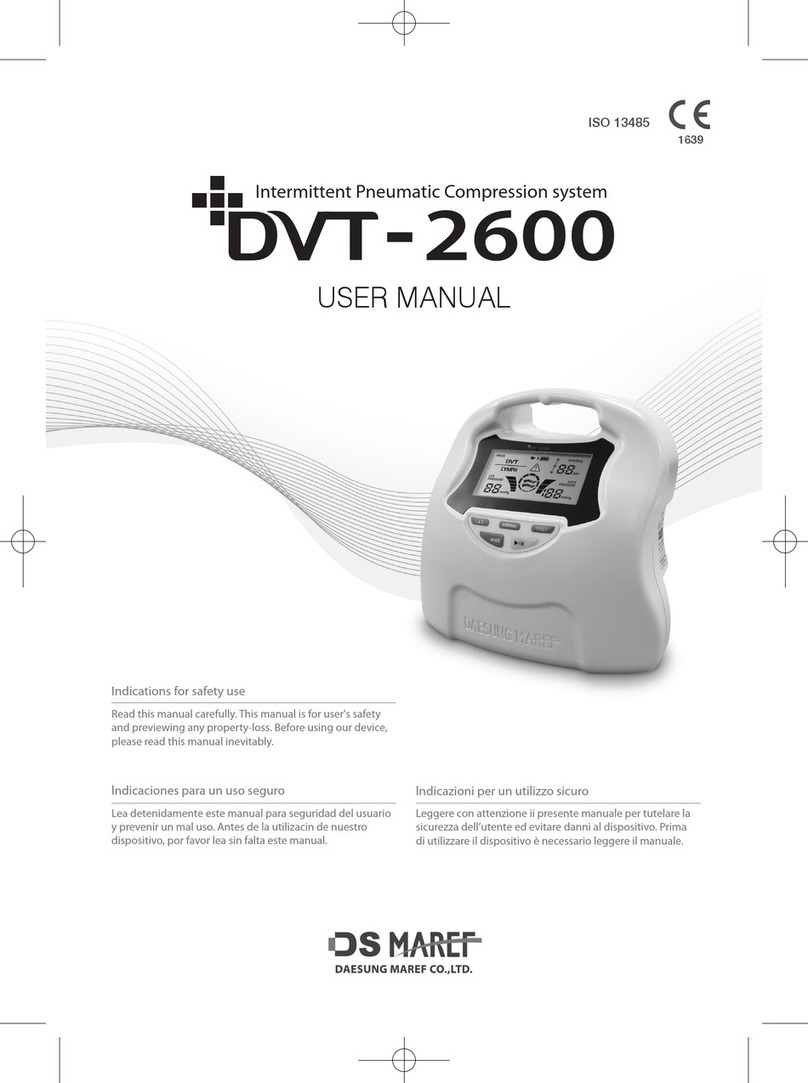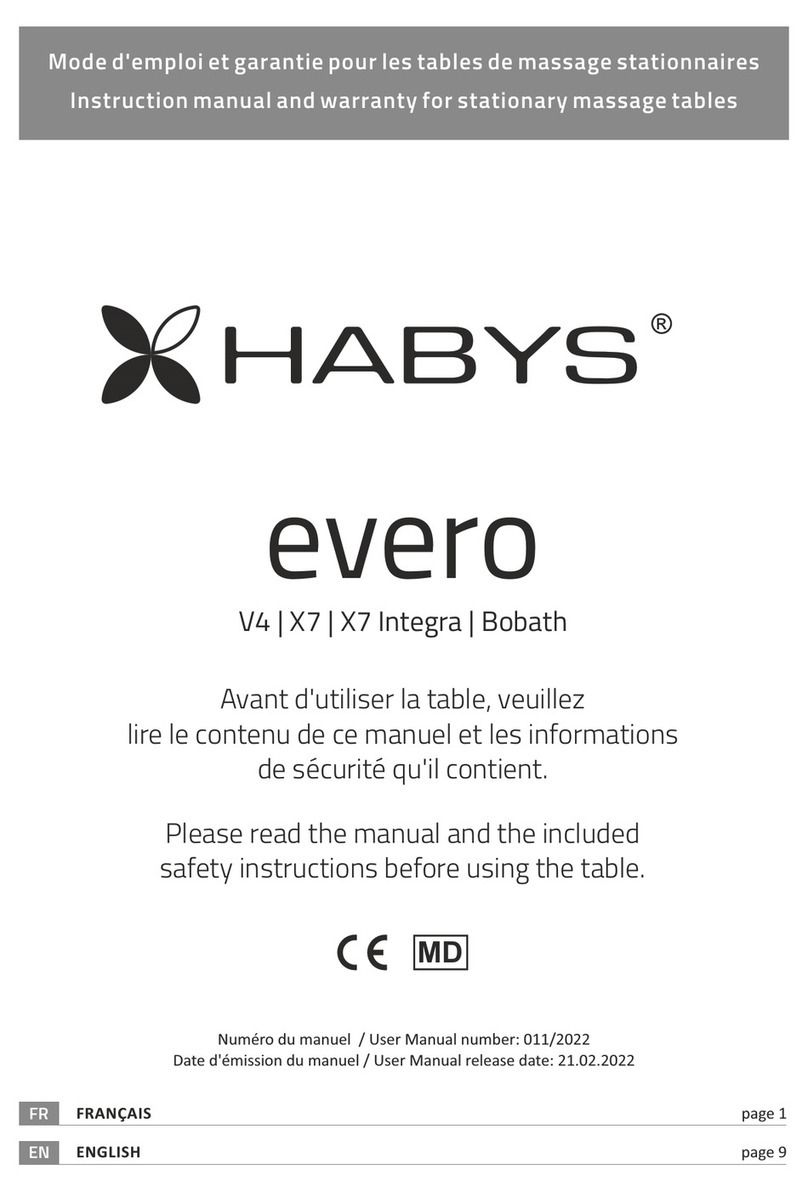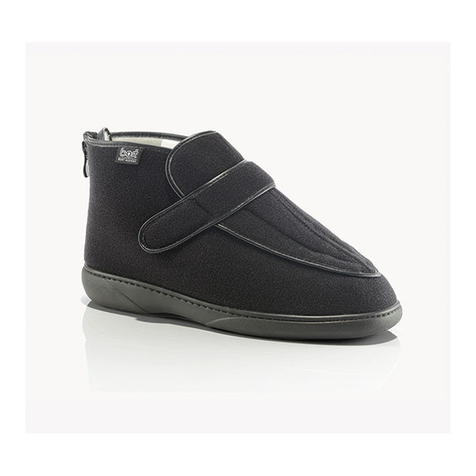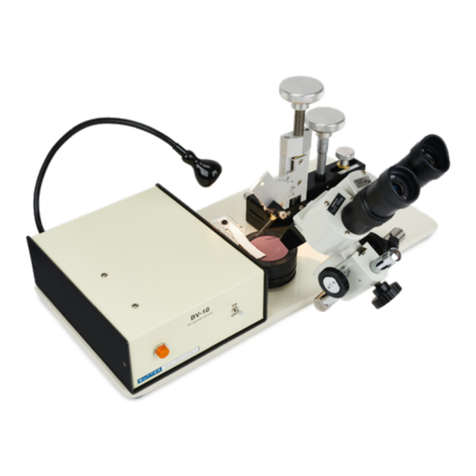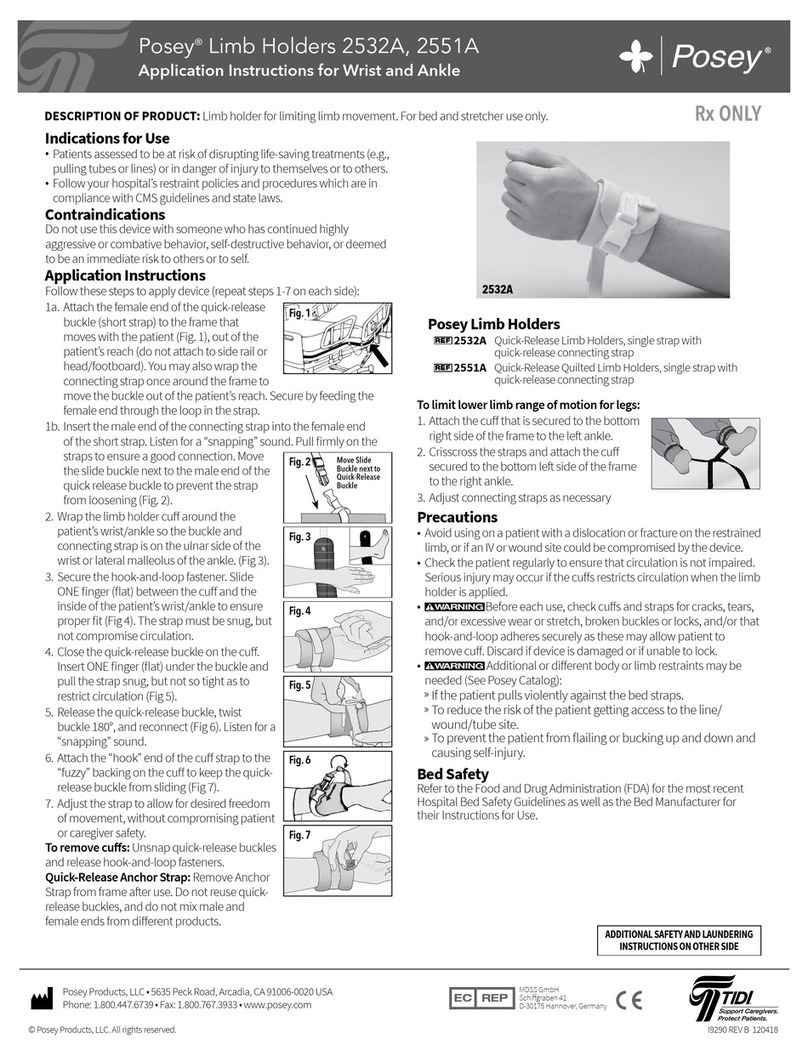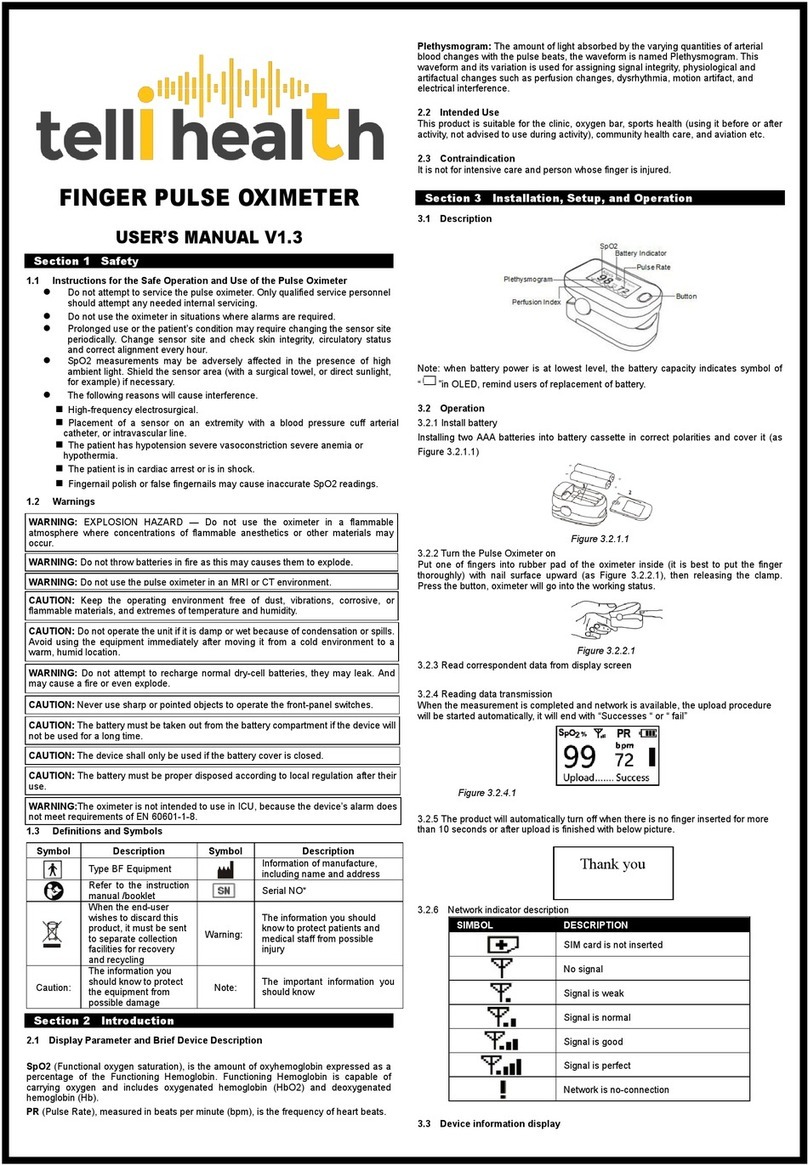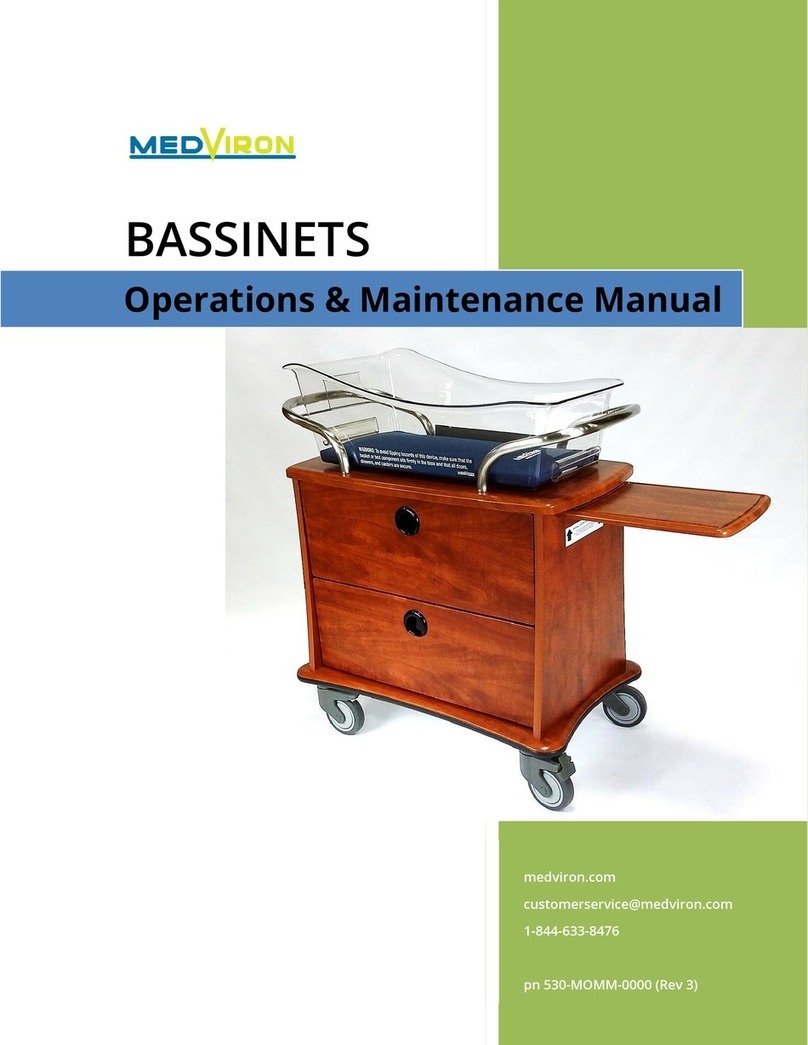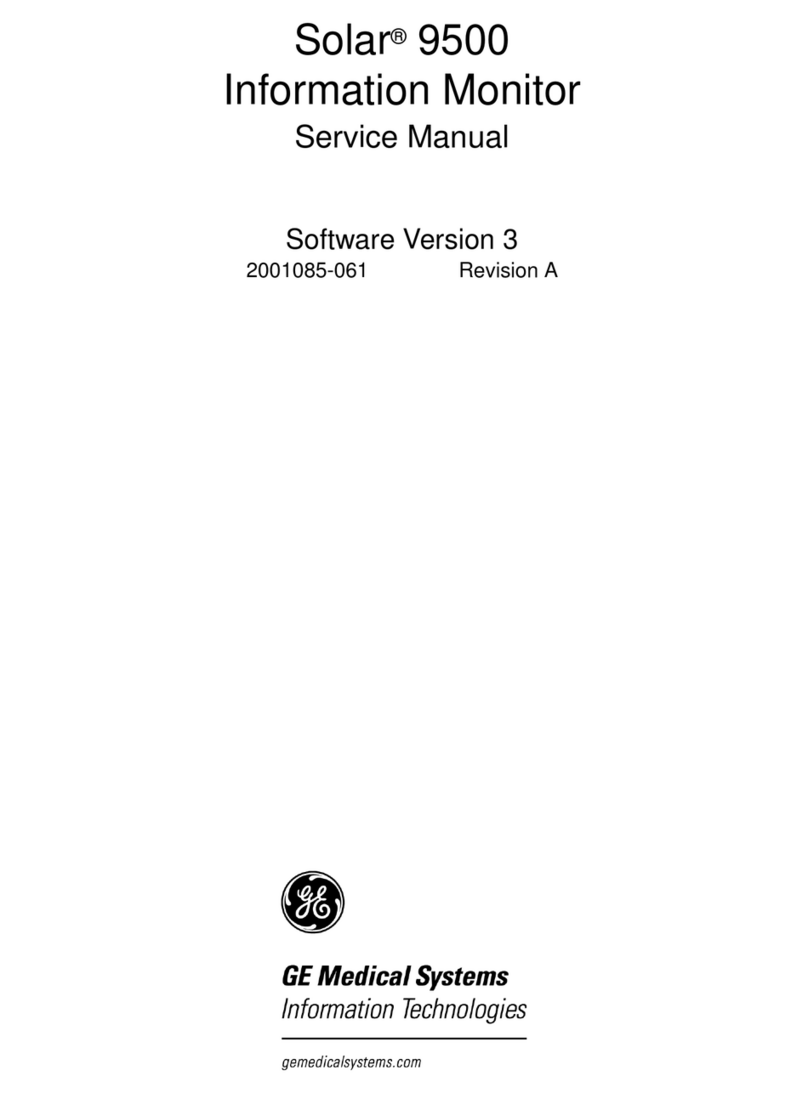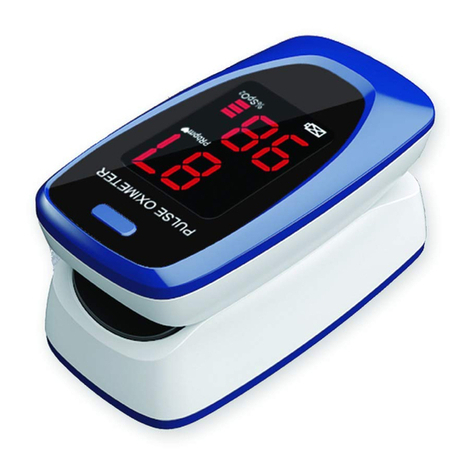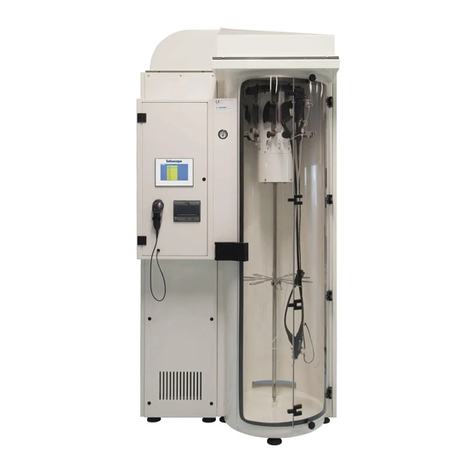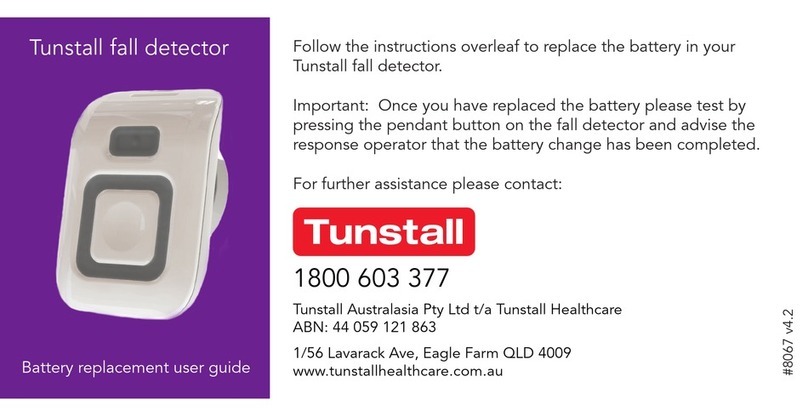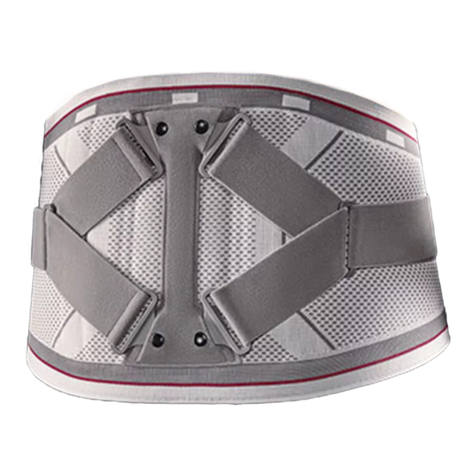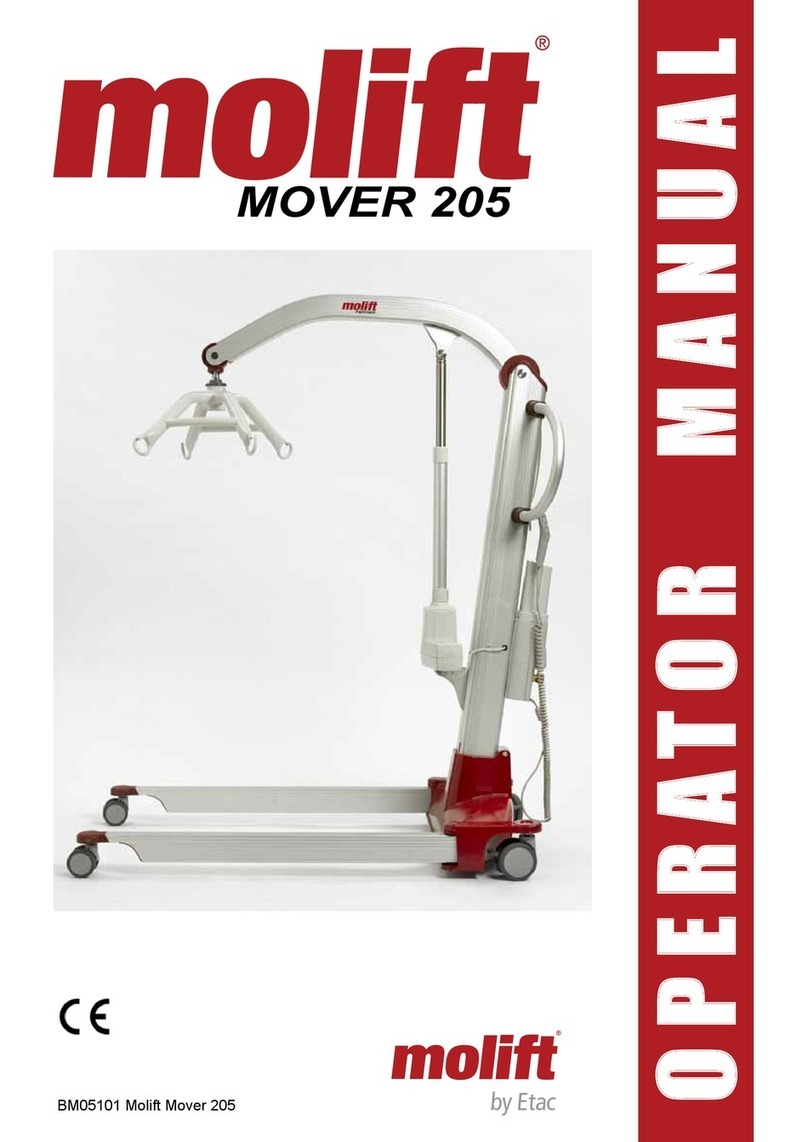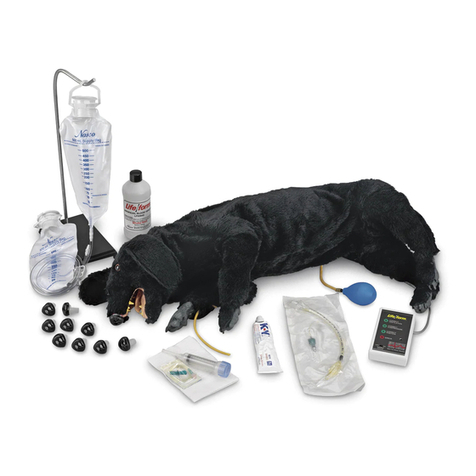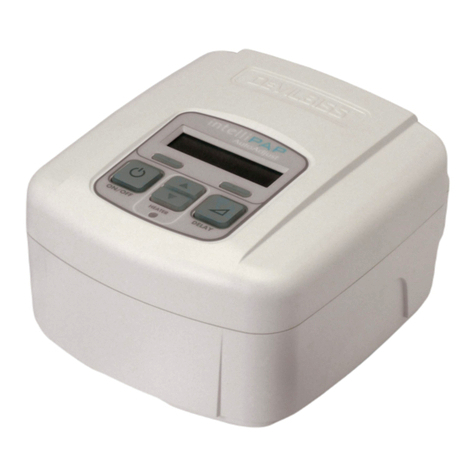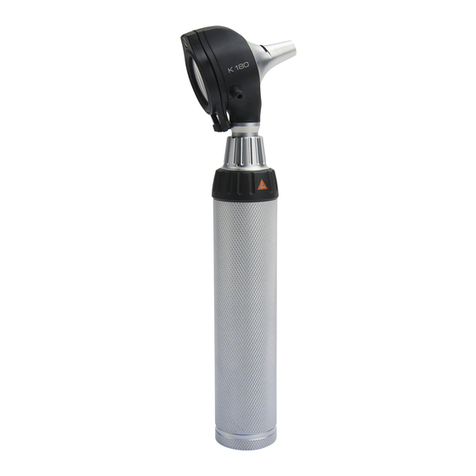Geister ESU-X 500 TT User manual

USER MANUAL FOR
ESU-X 500 TT (CL II BACCORDING TO CEE 93/42)
GEISTER Medizintechnik GmbH |Föhrenstrasse 2 |D-78532 Tuttlingen |Germany
Tel +49 (0) 7461 966 240 |Fax +49 (0) 7461 966 24 22 |Mail in[email protected]m |www.geister.com
Geister Medizintechnik GmbH
Föhrenstraße 2
78532 Tuttlingen / Germany
Tel.: +49-7461-96624-0
FAX: +49-7461-96624-22
E-Mail: info@geister.com
Read Instruction for use
0123
Medical product higher class I and shortcut for Notified Body TÜV SÜD Production
Service GmbH, München, Germany
Non sterile
Batch code
Catalogue number
Prescription - U.S. federal law restricts this device to sale by or on the order of a
physician or properly licensed practitioner
Protect from rain
Do not expose to sunlight

Dateiname mit Revisionsstand:
erstellt am:
erstellt von:
geprüft von:
freigegeben von:
Seite
ESU-X 500TT_EN B
01.06.15
cgro
cg
cgro
2 von 45
INTRODUCTION AND DIRECTIONS OF USE - Physical and electrical principles
of HF currents –Related risks
When electrical currents flow across biological tissues, they produce 3 effects: Electrolytic, Faradic and Thermal.
By applying a current, with frequency higher than 300kHz (named HF current), the electrolytic / faradic
phenomena either disappear or are very limited and the thermal one remains. This effect is exploited to obtain the
desired surgical result; in fact when an electric current with such characteristics crosses with sufficient density the
cellular liquid of the tissues, it warms it and generates what follows:
A heating so rapid that the vapor pressure into the internal and external liquids of cells breaks their
membranes and provokes their division: Pure Cut;
A heating, slower, which permits to the liquid to evaporate very slowly; in this way, the coagulating parts
of the tissues can coagulate: Coagulation;
A process which is in the middle between the two phenomena described above: Coagulating Cut.
This device allows the use of the HF currents in 2 ways - MONOPOLAR MODE AND BIPOLAR MODE.
MONOPOLAR MODE
This mode requires the use of two electrodes (the active one, small and used on the point of operation; the
neutral one, large and fixed on a different part of the patient’s body) and the current flows from the active to the
neutral electrode. The thermal effect affects all tissues included between electrodes.
BIPOLAR MODE
Also this mode requires two electrodes, but they are included in the same instrument and are very closed. In this
case the thermal effect produced by the current affects only a very small quantity of tissues.
RISKS CAUSED BY THE USE OF HF CURRENTS
The HF surgical devices are basic to solve surgical needs, but the use of HF currents, mainly when the
monopolar mode is used, presents also some risks. Here under some examples are detailed: Burns, on the
patient’s tissues where the neutral electrode is placed, caused by not sufficient contact. Burns on the surgeon’s
hand when the insulation of the active electrodes/instruments is damaged); Severe burns of patients /users
caused by the ignition/explosion of flammable/explosive gases or substances. In fact the normal sparks
generated during the delivery of power can ignite them. Bad functioning of other devices (pace‐maker, video
systems) provoked by EMC interferences emitted during the delivery of the HF currents; Damages of the patient’s
tissues caused by a delivery of too high powers. Slight neuromuscular stimulation, notably while using currents for
coagulation, where the active electrode and neutral one are used. This stimulation can be felt by patients or
surgeons like “an electrical discharge”.
DIRECTIONS FOR USE
These devices allow the surgeons to perform the following
During operations of major or medium surgery (Open Surgery, Laparoscopy/MIS, Endoscopic Surgery) in O.T. or
equivalent places: Monopolar Cut (Pure or Coagulating), Monopolar Coagulation (low, medium and high voltage),
Bipolar Cut, Bipolar Coagulation (Micro, Macro, Sealing of vessels and so on).

Dateiname mit Revisionsstand:
erstellt am:
erstellt von:
geprüft von:
freigegeben von:
Seite
ESU-X 500TT_EN B
01.06.15
cgro
cg
cgro
3 von 45
These units are intended to be used for
GYNAECOLOGY, ORTHOPAEDICS, ORL, UROLOGY, MAXILLOFACIAL SURGERY, DERMATOLOGY,
PLASTIC SURGERY, VASCULAR SURGERY, GENERAL OR THORACIC SURGERY, PAEDIATRIC
SURGERY, EMERGENCY SURGERY, GASTROENTEROLOGY, VETERINARY AND OTHER.
BASIC WARNINGS
The HF electrosurgical units are basic to solve many surgical needs, but the use of the HF currents also causes
specific risks and undesired side effects. Since the behavior of users is basic to reduce many risks, the
International IEC Standards for the safety of these devices establish:
All the hardware and software countermeasures needed to reduce risks.
All the warnings to detail in the use manual in order to inform operators about the safest way to use
them.
Because of previous reasons it is very important the following
That the device is used, only for the purposes listed in this manual, by qualified operators who are
experienced in electro‐surgery and all the related problems, risks and undesired side effects.
That users, before using the device, read this manual very carefully.
That operators use this device when applying all the warnings detailed in this manual.
GENERAL INFORMATION
Never use the unit if the electrical plant and the installations of the operating theatre do not comply with
the current safety standards. Never use extensions for the mains cord and, if many devices are
connected at the same time, ask the Technical Service about their compatibility.
Try to follow the suggested working times.
The smoke produced during the use of all HF units is biologically noxious. In USA, ENGLAND and so on
the Governmental and Technical Bodies recommend the use of Smoke evacuators to reduce this risk.
Always place the patient properly for the operation, especially in case of a long operation. The risk of
both burns and decubitus lesion rises in this case.
When using an HF unit for endoscopic procedures under liquid, it is advisable the monitoring of the
quantity of irrigation fluids in the patients (input and output volumes), mainly if they have a poor renal
function or cardiovascular insufficiency.
The unit is provided with self‐check systems which detect all faults, the mistakes of use, the absence or the
decrease of the power, the delivery of a power higher than that expected. The systems perform an auto‐check at
the switching on and they check the functioning during use. If the systems detect problems during the auto‐check,
they block the usability of the unit. If the systems detect problems during use, they stop the functioning. In all
cases, the systems inform the users by acoustic or visual signals and codes.
Because of this reason:
If, during use, the device doesn’t deliver the power (The normal powers appear less efficacious), but it has
properly passed the auto‐check at the switching on and the systems do not signal problems, users must not both
increase too much the power and think that the problem depends on the unit.
Users must check:
The good contact between the neutral electrode and patient’s tissues while using monopolar currents. The
conditions of cables and connectors, by bending and pulling them (They mainly break close to the instrument).
The assembly and the internal connections of all instruments, mainly if for endoscopy or laparoscopy. The
insulation of the blades of all bipolar scissors. (The continuous sliding damages it and causes a short circuit which
does not allow the current to reach tissues).
Users must clean:
The tips of all electrodes and instruments (If dirty, the current doesn’t reach tissues). The joints of the bipolar
instruments for laparoscopy (If dirty the current doesn’t reach tissues).
USE OF FLAMMABLE SUBSTANCES OR EXPLOSIVE GASES
Never use flammable substances (cleaning substances, disinfectants and so on) or explosive anesthetic
gases (i.e. oxygen, nitrogen protoxide) when using a HF device ! It is very dangerous since the spark
normally generated, during use, by the HF currents may cause the explosion of gases or the fire of
flammable materials and materials (cotton, gauze, sheets) which are oxygen saturated or soaked with
flammable substances.
Remember that, during use, a spark may cause the explosion of endogenous gases (I.E. Inside the
intestine).

Dateiname mit Revisionsstand:
erstellt am:
erstellt von:
geprüft von:
freigegeben von:
Seite
ESU-X 500TT_EN B
01.06.15
cgro
cg
cgro
4 von 45
ELECTRO‐MAGNETIC INTERFERENCES
The unit complies with all EMC standards, but it can, mainly during the monopolar use, damage the functioning
of:
Other devices used in O.T. (i.e. monitoring devices, video‐cameras, and so on). To reduce this problem,
connect the ESU to a mains socket different from that used to supply these devices and, if necessary,
ask for qualified technical assistance.
Pace‐makers, neuromuscular stimulators or other implanted devices when operating on patients with
these devices, ask for qualified advice from the Cardiology Division. Remember that the bipolar mode is
the best solution to operate these patients.
PREPARING AND POSITIONING OF THE PATIENT
Operators, when use a HF unit, must avoid all causes which can badly affect the path of the current and the
related thermal effect inside tissues because they cause the following risk. Burns of the patient’s tissues where
the density of current is too high. For example:
An implanted metallic prosthesis concentrates the passage of the current in the surrounding tissues.
Damp/wet sheets placed under or around the patient and the metallic trocars for laparoscopy can cause
an anomalous passage of the current.
To reduce this risk users must do the following:
Take all the metallic objects off the patient (rings, etc.), remember also that the metallic elements
(prosthesis, catheters, etc.) on the path of the current may cause increases of density of current;
When performing a laparoscopic procedure, check the insulation of trocars and instruments;
With dry sheets or other suitable materials insulate the patient from any metallic part connected to earth
or which may conduct electricity (operating table, supports). In the same way insulate the patient from
the heating mattress and the secreting parts of the body or the contacts skin‐to‐skin (i.e. between arms
and body). Remember that also the sweat can affect the insulation. During the operation, mainly if the
patient is moved or liquids are poured, verify if the insulation remains good.
When preparing the operating field, don’t use flammable disinfectants and take care that the used
disinfectants do not wet the sheets positioned under or around the patient. Also dry the traces of
disinfectant on the skin.
Place all the not specifically protected monitoring electrodes as far away as possible from the electrodes
of the HF unit. Avoid, if possible, the use of needle type or very small monitoring electrodes.
USE OF THE NEUTRAL ELECTRODE
When using monopolar currents, the bad contact of the neutral electrode causes two specific risks:
Burns on the tissues where the neutral electrode is fixed because the passage of the current is not
homogeneous (it flows through areas with better contact and worse contact) and it produces, in the
areas with better contact, a thermal effect so high to cause burns.
The bad functioning of the HF unit which leads users to raise the delivered powers and increases, in this
way, the risk of burns where the neutral electrode is positioned (higher power = higher risk).
In order to obtain the best and homogeneous contact, choose, use and place the neutral electrode (NE) as
follows:
Check that the NE, if it is a reusable type, is not either worn or damaged.
Place it on an area of the body as close as possible to the intervention point (the ideal is a soft part
without hairs, protuberant bones or superficial differences), but which not get wet both when preparing or
disinfecting the operating field and during use. Clean this area, shave it and massage it in order to
improve the circulation. Normally, the better points are calf and thigh, but obviously if the operation does
not affect these areas.
Fix the NE properly with the best possible contact, without placing anything in between, but do not press
it too much, in order to avoid ischemic zones. Avoid anomalous contacts (i.e. When positioning the
patient’s arm on the operating table, insulate the hand/ the fingers from the neutral electrode).
When preparing and disinfecting the operating field, avoid wetting the NE or the related area.
During use, mainly if the patient is moved or liquids are poured, verify if the intended contact remains
constant.
For the choice, according to specific needs) of the best “disposable” NE; contact the Technical Service.
Use a disposable NE only once and follow its instructions. The right dimensions are approx. 136cm2 for
patients with body weight higher than 15 Kg; approx. 84cm2 for children with body weight from 5 to 15
Kg. When using adhesive NE, do not rely on their characteristics only. The use of a supplementary fixing
grants a more reliable contact (i.e. an elastic bandage, able to cover the entire NE, but without pressing
it too much).

Dateiname mit Revisionsstand:
erstellt am:
erstellt von:
geprüft von:
freigegeben von:
Seite
ESU-X 500TT_EN B
01.06.15
cgro
cg
cgro
5 von 45
Remember that, mainly when high powers are used, if a “Split” NE is not used, the control circuit of the
unit can’t verify the contact between the NE and patient’s tissues; that is, it does not guarantee the
intended safety.
When fixing a “Split” NE, set it to obtain the same distance between both the parts of the NE and the
operation area (i.e. when intervening on the abdominal area, if the NE is on the thigh, place it lengthwise
on the leg).
As the space between the NE and the operating area represents a sort of “path” for the HF current, be
sure that it does not across diagonally the body or it crosses the heart.
USE OF CURRENTS AND POWERS
Check the features of its currents before using a new HF unit without considering the previous
experience with similar devices. Anyway, always start an operation with very low powers and then raise
them until the required result is reached.
Always use the lowest possible power. Do not exceed 1/4 of the maximum power of monopolar currents
when using neutral electrodes for pediatrics, or 1/6 when using neutral electrodes for new‐born.
Use the bipolar mode when operating on delicate or much innervated tissues, on small portions of tissue
or cavities, on patients with pace‐makers or similar devices and when the use of the neutral electrode is
difficult.
Remember that the use of too low powers can cause unexpected risks.
USE OF ACTIVE ACCESSORIES (ELECTRODES, PENCILS, INSTRUMENTS, CABLES, CONNECTORS)
Never use accessories (active electrodes, pencils, instruments, cables, connectors):
Not compliant with all the applicable technical / legislative Rules (I.E. Not EC approved)
Not well working or with damaged insulations (The bad insulation is the cause of the burns on the hand
of surgeons) and worn or dirty because they do not guarantee the safety, because they produce useless
superficial sparks and they cause an unstable functioning which can lead operators to increase powers
to dangerous levels. Always check them before the operation, mainly if they are for endoscopy.
Not suitable for the working voltages of the device:
Approx. 7600 Vpp. “4000 Vp” for the monopolar currents with crest factor equal or higher than 2.
Approx. 3600 Vpp “1800 Vp” for the monopolar currents with crest factor lower than 2.
Approx. 1100 Vpp “550 Vp” for the bipolar currents with crest factor equal or lower than 2.
When positioning the cables of the electrodes, avoid their contact both with the patient and with other
cables or conductive parts. During use, place unused electrodes or instruments on insulating materials.
If the carbonization of the tissues is not required, do not activate the monopolar currents (mainly the
currents for coagulation with high sparking) if the electrode does not touch the tissue.
The standard monopolar pencils are suitable to connect electrodes with stem Ø 2,3 mm.
SPECIFIC USE OF THE MONOPOLAR AND BIPOLAR INSTRUMENTS FOR LAPAROSCOPY
Use the instrument under visual control and, after each withdrawal, check that all parts are present.
Maintain a correct distance between the ends of the instrument and sensitive structures of the tissue.
Activate the current only if the ends of the instrument are in contact with the tissues to cut
/coagulate/seal. Never use, during the operation, a hot instrument (it means an instrument with hot ends)
for preparation.
Never use currents with automatic start/stop system.
SPECIFIC USE OF THE BIPOLAR INSTRUMENTS FOR VESSEL SEALING
In addition to the previous warnings, when using the instruments, mainly if for laparoscopy, prudentially
perform at least 2 seals (to the left and to the right of the point to cut) and verify if vessels are well
coagulated / sealed before cut it.
About the sticking of the tissue on the ends of the instrument, see the specific advices under detailed.
INFORMATIONS FOR THE BIPOLAR USE
USE OF BIPOLAR SCISSORS
Coagulate tissues by using “BLEND BICUT” or “MICRO” currents while cut them mechanically.
STICKING OF THE TISSUE ON THE TIPS OF BIPOLAR INSTRUMENTS
The sticking of the tissue on the tips of forceps/clamps is a normal a problem while using the bipolar currents for
coagulation and vessel sealing. To reduce it do the following:
When using forceps/clamps, irrigate , if possible, tissues with physiological solution.
Use all forceps/clamps damp or wet by physiological solution their tips. For example:
Damp tips before the use by a gauze and damp them again after 3 / 4coagulations.
Immerse tips in a bowl and wet again them in the same way after 3 / 4coagulations.

Dateiname mit Revisionsstand:
erstellt am:
erstellt von:
geprüft von:
freigegeben von:
Seite
ESU-X 500TT_EN B
01.06.15
cgro
cg
cgro
6 von 45
CHECK OF THE BIPOLAR INSTRUMENT BEFORE THE USE
Set a coagulation current (20/30)
Wet a gauze with physiological solution, and hold it without touching the wet part.
Touch the wet gauze with both ends of the instrument and activate the delivery. The smoke produced
signals the good functioning, otherwise check the connecting cable, the connections among different
parts of the instrument and the insulation of the ends For example the damage of the insulation of
bipolar scissors causes a short circuit which does not allow the current to reach tissues).
GENERAL TECHNICAL FEATURES
The unit includes a computerized system to automatically control the functioning
It performs a main self‐check at the switching ON (It repeats it automatically every about 30 minutes).
It stops the power delivery in case of both breakages and mistakes of use by informing users with
acoustic and visual signals (ERROR CODES).
It stores the detected problems to help the following technical assistance.
The unit includes with a computerized self‐control and self‐adjustment of currents with
PER (Power Efficiency Rating > 98%)
It automatically controls all currents according to the features of tissues with two different systems:
ADC System –Self adjusting with constant power
APC System
‐
Self adjusting with constant voltage
It also checks that the power delivery corresponds to intended setting and, in case of hardware or
software breakages which could cause an anomalous delivery, it blocks the delivery.
The unit allows the memorization of 99 programs
The programs can be also identified by a text (Name of users or kind of use).
All the setting of a program can be changed whenever users like
The unit includes some programs with a specific pre‐setting to facilitate the use.
The unit has 15 programs for the only bipolar use without the neutral electrode.
The unit is usable by one or two monopolar handles or instruments / the unit is always usable by one or
two bipolar instruments
The bipolar instruments are normally usable by foot‐switch, but the unit also includes some currents with
automatic “impedance sensing” start/stop systems.
The unit is usable by one or two twin foot‐switches
By the standard 34-9333 twin foot‐switch which is provided with a foot controlled selector to activate
either the monopolar currents or the bipolar currents.
By the bigger version of the previous model (34-9332 code) which is very useful for the endoscopy.
By an independent twin foot‐switch (34-9331) which activates the bipolar currents only.
By both foot‐switches (34-9331 and 34-9333).
By the 34-9333 twin foot‐switch to activate both the monopolar currents for cut and the bipolar currents
for coagulation or vessel sealing.
The unit has a control circuit of the neutral electrode which allows the users the following
The use either with normal electrodes for adults or with small electrodes for paediatrics or new born.
The use with neutral electrodes either “Single section ‐Non Split” or “Double section ‐Split”.
The use of connecting cables with different connectors: European standard and USA standard.
The unit includes the STANDBY mode
It allows the disconnection of the neutral electrode without the intervention of the related control circuit.
The unit includes with the function of self‐reset
It, at the switching on, resets all the setting used at the switching on.
The unit includes an automatic circuit to control the HF leakage currents to earth
CURRENTS AND RELATED FEATURES
All the monopolar and bipolar currents are automatically controlled, in real time, by microprocessors according to
the features “impedances / resistances” of tissues. The self‐control is different according to the operative need of
the currents:

Dateiname mit Revisionsstand:
erstellt am:
erstellt von:
geprüft von:
freigegeben von:
Seite
ESU-X 500TT_EN B
01.06.15
cgro
cg
cgro
7 von 45
ADC System –Self
‐
control with constant power. The power of these currents is shown, on the touch‐
screen, as Watts regarding the rated load.
APC System
‐
Self
‐
control with constant voltage. The power of these currents is shown, on the touch‐
screen, as effects (10 for each current) and, for each effect, it is also shown the maximum power.
The usability and the advisable starting setting of all the currents is detailed in the SECTIONS dedicated to the
different surgical uses.
CURRENTS FOR MONOPOLAR CUT AND COAGULATING CUT
PURE CUT (ADC System Control). Cut without coagulating effect.
BLEND CUT 1 (ADC System Control). Cut with soft coagulating effect.
BLEND CUT 2 (ADC System Control).Cut with very strong coagulating effect (2% cut + 98%
coagulation).
PURE CUT PULSED (ADC System Control). Pulsed cut without coagulating effect.
BLEND CUT PULSED (ADC System Control). Fast pulsed cut with coagulating effect.
AUTO PURE MICRO (APC System Control). Delicate cut without coagulating effect.
AUTO BLEND CUT MICRO (Self‐control APC System). Delicate cut with coagulating effect.
AUTO PAPILLO PURE CUT (APC System Control). Pure cut.
It has 4 delivery modes: continuous or pulsed with slow modulation, medium modulation and fast
modulation.
AUTO POLIPO BLEND CUT (APC System Control). Coagulating cut.
AUTO ENDO CUT (APC System Control). Current with phases of cut and coagulation.
CURRENTS FOR MONOPOLAR COAGULATION
FULG FORCED COAG (ADC System Control). Coagulation with strong superficial sparking.
SPRAY COAG (ADC System Control). No‐contact coagulation with very strong sparking.
PIN POINT CONTACT COAG (ADC System Control). Coagulation with medium superficial sparking.
SOFT MICRO COAG (ADC System Control). Coagulation with very low superficial sparking.
PULSED SPRAY COAG (ADC System Control). Pulsed, delicate coagulation.
CURRENTS FOR BIPOLAR CUT
STANDARD BICUT (ADC System Control). Cut of dried or wet tissues.
BLEND BICUT (ADC System Control). Cut with strong coagulation (98% coagulation).
SALINE URO
‐
GYN CUT (ADC System Control). Cut for the endoscopic use in saline with continuous or
pulsed delivery.
SALINE ARTHRO CUT (ADC System Control). Cut for the arthroscopic use in saline with continuous or
pulsed delivery.
CURRENTS FOR BIPOLAR COAGULATION AND VESSEL‐SEALING
SOFT MICRO BICOAG (APC System Control). Delicate and precise coagulation.
FORCED MICRO BICOAG (ADC System Control). Fast coagulation.
AUTO SOFT MICRO BICOAG (APC System Control). Current identical to the SOFT MICRO BICOAG.
It has an automatic “impedance sensing” start/stop system.
SEALING (APC System Control). Coagulation/ vessel sealing of vessels with diameter up to 8 mm.
It starts by using the foot‐switch, but has an automatic “impedance sensing” stop system.
AUTO SEALING (APC System Control). Current identical to the SEALING.
It has an automatic “impedance sensing” start/stop system.

Dateiname mit Revisionsstand:
erstellt am:
erstellt von:
geprüft von:
freigegeben von:
Seite
ESU-X 500TT_EN B
01.06.15
cgro
cg
cgro
8 von 45
CURRENTS AND RELATED FEATURES
Monopolar Currents
Max
Power
Rated
Load
Vpp
Frequency (F) –Crest Factor (CF)
Modulation (M) ‐Duty Cycle (DT)
Acoustic and
luminous signals
PURE CUT
400 W
400 Ω
2550
F: 440 kHz ‐CF: 1,46 ‐M: 0 ‐DT: 100%
Low sound, Yellow light
BLEND CUT 1
300 W
400 Ω
3390
F: 440 kHz ‐CF: 1,94 ‐M: 17kHz ‐DT:95%
Ditto
BLEND CUT 2
250 W
400 Ω
3330
F: 440 kHz ‐CF: 2,29 ‐M: 17kHz ‐DT: 65%
Ditto
PURE CUT PULSED
400 W
400 Ω
2640
F: 440 kHz ‐CF: 2 ‐M: 3Hz ‐DT: 50%
Ditto
BLEND CUT PULSED
250 W
400 Ω
3330
F: 440 kHz ‐CF: 3,2 ‐M: 5OHz ‐DT: 50%
Ditto
AUTO PURE MICRO
300 W
300 Ω
1137
F: 440 kHz ‐CF: 1,5 ‐M: 0 ‐DT: 100%
Ditto
AUTO BLEND CUT MICRO
300 W
300 Ω
1500
F: 440 kHz ‐CF: 1,98 ‐M: 17kHz ‐DT: 90%
Ditto
AUTO PAPILLO PURE CUT
300 W
300 Ω
1140
F: 440 kHz ‐CF: 1,5 ‐M: 0 ‐DT: 100%
Ditto
AUTO POLIPO BLEND CUT
300 W
300 Ω
1490
F: 440 kHz ‐CF: 1,98 ‐M: 17kHz ‐DT: 95%
Ditto
AUTO ENDO CUT
300 W
300 Ω
1670
50% AUTO PURE 50% AUTO BLEND
Ditto
FULG FORCED COAG
150 W
300 Ω
4500
F: 440 kHz ‐CF: 6,4 ‐M: 60kHz ‐DT: 18%
Acute Sound, Blue light
SPRAY COAG
200 W
700 Ω
7750
F: 440 kHz ‐CF: 7,75 ‐M: 30kHz ‐DT: 7%
Ditto
PIN POINT CONTACT COAG
300 W
400 Ω
3700
F: 440 kHz ‐CF: 2,2 ‐M: 17kHz ‐DT: 85%
Ditto
SOFT MICRO COAG
280 W
300 Ω
3300
F: 440 kHz ‐CF: 2,1 ‐M: 17kHz ‐DT: 75%
Ditto
PULSED SPRAY COAG
200 W
700 Ω
7850
F: 440 kHz ‐CF: 11,5 ‐M: 3 Hz ‐DT: 50%
Ditto
Bipolar Currents
Max
Power
Rated
Load
Vpp
Frequency (F) –Crest Factor (CF)
Modulation (M) ‐Duty Cycle (DT)
Acoustic and
luminous signals
STANDARD BICUT
200 W
300 Ω
1070
F: 440 kHz ‐CF: 1,5 ‐M: 0 ‐DT: 100%
Acute Sound, Blue light
BLEND BICUT
160 W
200 Ω
740
F: 440 kHz ‐CF: 1,6 ‐M: 17kHz ‐DT: 95%
Ditto
SALINE URO‐GYN CUT
350 W
350 Ω
1070
F: 440 kHz ‐CF: 1,5 ‐M: 0 ‐DT: 100%
Ditto
SALINE ARTHRO CUT
240 W
350 Ω
1070
F: 440 kHz ‐CF: 1,5 ‐M: 0 ‐DT: 100%
Ditto
SOFT MICRO BICOAG e
AUTO SOFT MICRO BICOAG
140 W
100 Ω
460
F: 440 kHz ‐CF: 1,6 ‐M: 0 ‐DT: 100%
Acute Sound, Blue light
FORCED MACRO BICOAG
200 W
100 Ω
550
F: 440 kHz ‐CF: 1,6 ‐M: 0 ‐DT: 100%
Ditto
SEALING e AUTO SEALING
300 W
50 Ω
320
F: 440 kHz ‐CF: 1,46 ‐M: 0 ‐DT: 100%
Ditto
CONTROL DEVICES, SOCKETS FOR CONNECTIONS AND SYMBOLS

Dateiname mit Revisionsstand:
erstellt am:
erstellt von:
geprüft von:
freigegeben von:
Seite
ESU-X 500TT_EN B
01.06.15
cgro
cg
cgro
9 von 45
The lights of the sockets switch ON, according to the selected use, to highlight the usable socket.
A
Touch-screen
B
PS Keys to set the power of currents
1, 2
Sockets to connect the twin foot-switches
3, 5
Sockets to connect the monopolar accessories
4
Socket to connect either a monopolar electrode
7
Socket to connect the neutral electrode
8
Sockets to connect the bipolar accessories
C
Mains switch
E
Plug for the equipotential connection
F
Socket for the supply cord with fuse block
D, G, H
Not used
Alternating current (on the data label)
Earth protection (inside the unit)
Apparatus of Class I Type CF, protected against the defibrillator effects (a CF type unit guarantees the
highest safety level against direct and indirect contacts, notably for the allowable leakagecurrents). The
applied part type F (floating) is protected from the earth at high and low frequencies. This kind of unit is
especially indicated for direct heart application.
GEISTER MEDIZINTECHNIK GMBH guarantees safety, reliability and performances of this unit only if
installation, recalibrations and repairs are carried out, using original spare parts, by personnel
authorized by GEISTER and if the unit is used in compliance with given instructions in an area that
meets all the applicable IEC or CEI requirements.
GEISTER is at disposal to supply, if requested, the electric diagrams and any further information needed.
This manual must be kept where the unit is employed. Please read this entire manual carefully to become
familiar with each of the controls and features before making any attempt to use the equipment clinically and ask
it again in case missing.
If any questions arise regarding the information contained in this manual according to specific needs, please
contact the Manufacturer, directly or through the local distributor, before using the unit. In accordance with the
requirements of the European Directive for medical devices 93/42 CEE and with the procedures of Company
Quality System for the after-sale control of the production, the users are pleased to inform the Manufacturer
about every, even little, problem of this unit.
PEDAL‐1 and PEDAL –2 sockets
PEDAL‐1 socket: Connection of the 34-9333 standard foot‐switch provided with a foot‐selector to
activate either the monopolar currents or the bipolar currents. The model 34-9332 (Identical but larger for
the endoscopy) is available on request.
PEDAL‐2 socket: Connection of the 34-9331 foot‐switch to activate the bipolar currents only. When
connecting both foot‐switches, the 34-9333 activates the monopolar currents and the 34-9331 activates
the bipolar currents.

Dateiname mit Revisionsstand:
erstellt am:
erstellt von:
geprüft von:
freigegeben von:
Seite
ESU-X 500TT_EN B
01.06.15
cgro
cg
cgro
10 von 45

Dateiname mit Revisionsstand:
erstellt am:
erstellt von:
geprüft von:
freigegeben von:
Seite
ESU-X 500TT_EN B
01.06.15
cgro
cg
cgro
11 von 45
NEUTRAL PLATE socket
(When the 7a NP‐1 light is ON) The related socket allows the use of a cable with the standard,
European, connector (Jack Ø6,35 mm).
(When the 7b NP‐2 light is ON) The related socket allows the use of a cable with the American
connector “Valleylab” standard.
For the complete functioning of the control circuit and for the selection of the socket, see the paragraph
”CONTROL CIRCUIT OF THE NEUTRAL ELECTRODE”.
Use the RD/EN1 adaptor to connect a cable with connector American standard
MONOPOLAR –1 socket
When the 3a HAND‐SWITCHED light is ON. It allows the use of a hand‐switched handle or instrument.
The socket allows the use of accessories with the connector “3 pins ‐international type”.
When the 5a FOOT SWITCHED light is ON. It allows the use of a foot‐switched accessory (Handle,
instrument, endoscope and resectoscope. The socket allows the use of accessories with the connector
“plug Ø 6 mm with hole Ø 4 mm”.
Use the RD/5 adaptor to use accessories with cables having all the following connectors different from the
standard one:
Cables with “MARTIN” connector or equivalent
Cables with “diameter from 2 to 5 mm” plug (ERBE, STORZ, and so on)
Cables with “diameter 8mm” plug (USA, VALLEYLAB, and so on)

Dateiname mit Revisionsstand:
erstellt am:
erstellt von:
geprüft von:
freigegeben von:
Seite
ESU-X 500TT_EN B
01.06.15
cgro
cg
cgro
12 von 45
MONOPOLAR –2 socket
When the 4a HAND‐SWITCHED light is ON. It allows the use of a hand‐switched handle or instrument.
The socket allows the use of accessories with the connector “3 pins ‐international type”.
BIPOLAR –1 and BIPOLAR ‐2 sockets
When the 8b light is ON : only the BIPOLAR‐2 socket is usable. All the currents, for cut and coagulation
or vessel sealing, are delivered through it.
When 8b and 8a lights are ON : both sockets, BIPOLAR‐1 e BIPOLAR‐2, are usable. The currents for
cut are delivered through the first socket, the currents for coagulation or vessel sealing are delivered
through the second socket.
The sockets allow the use of accessories with 2 plugs Ø 4 mm connector
To select them, see the GENERAL MENU, section “bipolar output selection”.
To use accessories with cables having connectors different from the standard one, use the following
adaptors:
RD/BF1: To use cables with connector ERBE, STORZ type.
RD/BF2: To use cables with connector MARTIN type.

Dateiname mit Revisionsstand:
erstellt am:
erstellt von:
geprüft von:
freigegeben von:
Seite
ESU-X 500TT_EN B
01.06.15
cgro
cg
cgro
13 von 45
TOUCH SCREEN
GENERAL IMAGE
In this case the unit allows the use of the monopolar and bipolar currents.
1
standby key –It allows the selection of the STANDBY mode. See the paragraph STANDBY
2
menu key –It allows the selection of the GENERAL MENU of functioning. See, in the next page, the
paragraph GENERAL MENU.
3
Control key to memorize and use the programs. See the paragraph MEMORIZATION AND USE OF
PROGRAMS.
4
Keys and lights of the control circuit of the neutral electrode. See the paragraph CONTROL CIRCUIT
OF THE NEUTRAL ELECTRODE.
5
Area to select and set currents and powers. See the paragraph FIRST SETTING.
5.1 –Monopolar cut and coagulating cut.
5.2 –Monopolar coagulation.
5.3 –Bipolar cut.
5.4 –Bipolar coagulation and vessel sealing.
6
hf leakage alarm light of the control circuit of the HF leakage currents to earth. See the paragraph
CONTROL OF HF LEAKAGE CURRENTS TO EARTH.
GENERAL MENU
This menu allows the performing of the general, modes of functioning. To select it push the menu key on the
touch‐screen. To exit push the exit key.

Dateiname mit Revisionsstand:
erstellt am:
erstellt von:
geprüft von:
freigegeben von:
Seite
ESU-X 500TT_EN B
01.06.15
cgro
cg
cgro
14 von 45
2.1
SECTION: SOUND
By rotating the control when the BEEP is ON, users can change the level of the sounds which signal
both the delivery of currents and the use of keys. All acoustic alarm signals are fixed, not adjustable.
2.2
SECTION: BEEP ON/OFF
By pushing the key, users can set the acoustic signal of the keys on the panel.
2.3
SECTION: NEUTRAL PLATE SOCKET SELECTION
By using the key, users can select the socket to connect the neutral electrode:
Socket to connect a cable with European, standard (jack Ø 6,35 mm) connector.
Socket to connect a cable with American, Valleylab type, connectors.
See the paragraph CONTROL CIRCUIT OF THE NEUTRAL ELECTRODE.
2.4
SECTION: ACTIVATION PEDAL 1 SELECTION
By pushing the key, users can manually set the functioning mode of the standard, main, twin foot‐
switch 34-9333. See the paragraph CONNECTION AND USE OF FOOT‐SWITCHES.
2.5
SECTION: BIPOLAR OUTPUT SELECTION
By pushing the key, users can select the sockets to connect the bipolar instruments:
Only the BIPOLAR‐2 socket / Both sockets: BIPOLAR‐1 and BIPOLAR‐2.
2.6
SECTION: AUTO BIP START DELAY
By rotating the control, users can set the delay (from 0.1 to 5 seconds) of activation of the bipolar
currents with automatic “impedance sensing” start/stop:
AUTO SOFT MICRO BICOAG for coagulation / AUTO SEALING for vessel sealing.
2.7
SECTION: LCD color
By pushing the key, users can set the colour (green/red) of the numbers on the touch screen.
LANGUAGE OF THE TOUCH‐SCREEN
To set the language, push the display 2 of the upper part of the touch‐screen
until opening the specific page of the menu and push the button of the
language.
SELF‐CHECK
THE UNIT IS PROVIDED WITH A SELF‐CHECK SYSTEM OF THE FUNCTIONING
The system, at the switching ON, performs a complete self‐check which ends only if the unit operates perfectly.
The unit signals this phase, by specific codes on the touch screen. The system, during use, performs the
following:
It always checks both the functioning and the delivered powers.
It repeats, every about 20 minutes the complete self‐test without disturbing the normal use.
It also checks the mistakes of use (For example the not correct use of an activation switch).
In all cases the system, if it detects both breakages and mistakes of use, blocks the the delivery of powers by
signalling the problem with specific alarms and error codes. In case of the signals detailed in the TABLE I, users
can eliminate the cause. In case of other signals, users can switch the unit OFF/ON to verify the alarm and, if it is
confirmed, ask for the Technical assistance.
MEMORIZATION OF THE DETECTED ERROR CODES.

Dateiname mit Revisionsstand:
erstellt am:
erstellt von:
geprüft von:
freigegeben von:
Seite
ESU-X 500TT_EN B
01.06.15
cgro
cg
cgro
15 von 45
The unit stores the detected error codes to help the Technicians in finding a solution for the problems. The
procedure to perform the related control is detailed in the Service Manual.
BECAUSE OF THE PREVIOUS REASONS, DURING THE USE
Users must not both increase too much the power and think that the problem depends on the unit:
If the unit doesn’t deliver the power (The normal powers appear less efficacious), but it has properly
passed the auto‐check at the switching on and the systems do not signal problems.
Users must check:
The good contact between the neutral electrode and patient’s tissues while using monopolar currents.
The conditions of cables and connectors, by bending and pulling them.
(They mainly break close to the instrument).
The assembly and the internal connections of all instruments, mainly if for endoscopy or laparoscopy.
The insulation of the blades of all bipolar scissors. (The continuous sliding damages it and causes a
short circuit which does not allow the current to reach tissues).
Users must clean:
The tips of all electrodes and instruments (If dirty, the current doesn’t reach tissues).
The joints of the bipolar instruments for laparoscopy (If dirty the current doesn’t reach tissues).
Cause or problem
Acoustic and Visual signals or Error codes
Fairly good contact of a “SPLIT‐Double section” neutral
electrode (When using this type).
Not.
Light 1 ON.
Symbols (EL or ES) black.
Poor contact of a “SPLIT‐Double section” neutral electrode
(When using this type).
1 Tone.
Lights 1and 2 ON.
Symbols (EL or ES) black.
Very poor contact of a “SPLIT‐Double section” neutral
electrode (When using this type).
2 Tones.
Lights 1, 2 and 3 ON.
Symbols (EL or ES) black.
Not sufficient contact of the “SPLIT‐Double section” neutral
electrode (When using this type).
All the neutral electrodes “SPLIT‐Double section or NON
SPLIT‐Single section” are not connected to theunit. (When
using any of these types).
The cable of the neutral electrodes is broken.
Continuous,
pulsed,
tone.
Lights 1, 2, 3 and 4 ON.
Symbols (EL or ES) red.
+ Neutral plate alarm.
HF Leakage currents to earth too high. See the par.”Check of
the HF Leakage currents to earth
N/A
Light „h.f. leakage“
Not allowed use of an activation switch.
Yes
Not allowed handle or pedal
activation.
Not allowed use of two activation switches.
Yes
Simultaneous handle or pedal
activation.
Delivery of currents longer than 40 seconds. Stop the delivery
for an instant and then start it again.
Yes
Over Time Activation Error
It is for information only!
INITIALS CHECKS AND EQUIPOTENTIAL CONNECTION
Verify that the mains power supply corresponds to the technical data (see the data label on the back).
Connect the unit to the mains supply with the mains switch (C, green ‐on the back) off.
To perform, if needed, the equipotential connection, use the specific plug (E ‐on the back).
DATA STORING AT THE SWITCHING ON
The unit always re‐sets at the switching on, intentional or caused by a temporary loss of supply, the settings used
at the switching off. It does not maintain the following:
The selection of the AUTO SOFT MICRO BICOAG and AUTO SEALING bipolar currents with automatic
“impedance sensing” start/stop. (IEC Standards establish that a current with automatic start/stop system
has to be intentionally selected by users at the switching ON)
If the memory number is blinking at the switching OFF, it blinks again at the following switching ON and the unit
resets the same setting. About the blinking of the memory number see the Par “BLINKING OF A MEMORY
NUMBER.
CHECK OF THE HF LEAKAGE CURRENTS TO EARTH
All HF currents also generate leakage currents to earth which, according to the safety standards for the
electrosurgical devices, have to be lower than 150 mA to reduce the risk of burns on patient’s tissues. The unit is
provided with a specific circuit which checks these currents and, if they go over the allowed limit, intervenes as
follows:
It automatically reduces the output power (These currents depend on the power)

Dateiname mit Revisionsstand:
erstellt am:
erstellt von:
geprüft von:
freigegeben von:
Seite
ESU-X 500TT_EN B
01.06.15
cgro
cg
cgro
16 von 45
It informs users by an alarm signal (HF LEAKAGE light ON).
CONTROL CIRCUIT OF THE NEUTRAL ELECTRODE
The unit is provided with a control circuit which allows the users the following:
The use with electrodes for adults (Dimensions of, at least, 136 cm 2).
The use with small electrodes for paediatrics (Dimensions of, at least, 86 cm 2) or new born.
The use of all neutral electrodes: Single section “Non Split” and Double section “Split”.
The use with both reusable, normal, electrodes and with single use, adhesive, electrodes.
The use of connecting cables with different connectors:
European standard jack Ø 6, 35 mm
USA standard with 2 pins (I.E. Valleylab type).
The keys, the symbols and the lights of the circuit are in the same area of the screen.
LARGE /SMALL Keys
They are used to select the operation mode:
With electrodes for adults.
With electrodes for paediatrics or new born.
EL / ES Symbols
They are used to identify the operation mode. 1, 2, 3, 4 Alarm Lights.
The circuit operates in different ways according to the electrode (Split, Non‐Split). The circuit does not intervene
when selecting the memories for the bipolar use only. In this case the 1, 2, 3, 4 lights and the EL, ES symbols are
ON, but for information only.
SETTING OF THE OPERATION MODE
The circuit has two operation modes: With electrodes for either adults or paediatrics / new born. To set the
operation mode push the LARGE/SMALL keys.
LARGE (Use with standard electrodes for adults). This mode allows the delivery of the maximum
available power.
SMALL (Use with small electrodes for paediatrics or new born) This mode allows the delivery of
maximum 150W.
SETTING OF THE SOCKET TO CONNECT THE CABLE OF THE NEUTRAL ELECTRODE
By pushing the menu key of the touch screen, select the GENERAL MENU.
By pushing the key of the section “neutral plate socket selection”, select the socket: NP‐1 socket (Light
7a ON) to use the connector jack Ø 6, 35 mm (European standard) NP‐2 socket (Light 7b ON) to use the
connector “2 pins” (USA, Valleylab, Conmed standard).
Exit from the GENERAL MENU by pushing the exit key. To connect a cable with the USA connector use
the RD/EN1 adaptor.
OPERATION OF THE CIRCUIT
The circuit, when using the normal “NON‐SPLIT” electrodes checks only the connection of the cable:
If the cable is well connected to the electrode.
If the cable is well connected to the unit.

Dateiname mit Revisionsstand:
erstellt am:
erstellt von:
geprüft von:
freigegeben von:
Seite
ESU-X 500TT_EN B
01.06.15
cgro
cg
cgro
17 von 45
If the cable is broken.
The circuit operates as follows:
CABLE
ALARM SIGNALS
POWER
DELIVERY
MAXIMUM
DELIVERED POWERS
-
Acoustic
Visual
-
Mode LARGE
Mode SMALL
Well connected.
Not
Not
Yes
Not limited.
Max.150W.
Broken.
Not connected
either to the unit or
to the electrode
Continuous
Intermittent
tone.
Lights 1, 2, 3, 4
ON.
Symbols EL and
ES ON.
Error code
Alarm neutral
plate.
Blocked
Power
delivery
blocked.
Power
delivery
blocked.
The circuit, when using the “SPLIT” electrodes checks the following:
The connection of the cable as above detailed.
If the electrode is well connected to the patient’s tissues.

Dateiname mit Revisionsstand:
erstellt am:
erstellt von:
geprüft von:
freigegeben von:
Seite
ESU-X 500TT_EN B
01.06.15
cgro
cg
cgro
18 von 45
The circuit operates as follows:
CONTACT
Electrode/Tissues
ALARM SIGNALS
POWER
DELIVERY
MAXIMUM
DELIVERED POWERS
-
Acoustic
Visual
-
Mode LARGE
Mode SMALL
Good.
Not.
No
Yes.
Not limited.
Max.150W.
Fairly good.
Not.
Light 1 ON. (1)
Symbols EL and
ES OFF.
Yes.
Not limited.
Max.150W.
Poor.
1 Tone.
Lights 1, 2 ON.
Symbols EL and
ES OFF.
Yes.
Limited
Max.150W
Max.80W.
Very poor.
2 Tones.
Lights 1, 2, 3 ON.
Symbols EL and
ES OFF.
Yes.
Limited
Max.150W
Max.80W.
Insufficient.
Continuous
Intermittent
tone.
Lights 1, 2, 3, 4
ON.
Symbols EL and
ES ON.
Error code
Alarm neutral
plate
Blocked.
Power
delivery
blocked.
Power
delivery
blocked.
(1) The switching ON of the 1 socket is normal when using small electrodes for new born.
STANDBY
The unit is provided with the STANDBY mode. When selecting it the unit operates as follows:
The unit is totally usable, but the power delivery is blocked.
The control circuit of the neutral electrode does not emit alarm signals if users disconnect the neutral
electrode.
To select the standby, push the standby key of the touch‐screen (It blinks)
To exit from the standby, push the standby key of the touchscreen (It switches OFF)
USE OF THE FOOT‐SWITCHES
The units are usable by the following two twin foot‐switches:
The standard 34-9333DSmodel and the, on request, 34-9331 model.
It is available, on request, the 34-9332 model (larger version of the 34-9333) for the endoscopy. In this
manual when we say 34-9333.
The 34-9333 is provided with a foot selector to allow the surgeon to select either the activation of the
monopolar currents or the activation of the bipolar currents.
The 34-9331 allows the activation of the bipolar currents only.
34-9333
34-9332
34-9331
It has a connector with 5 pins.
It has a connector with 5 pins.
It has a connector with 7 pins.
The sockets to connect them are : PEDAL‐1 = 34-9333 (or 34-9332), PEDAL‐2 =34-9333 (or 34-9332)
The use by foot‐switch is mistake proof!

Dateiname mit Revisionsstand:
erstellt am:
erstellt von:
geprüft von:
freigegeben von:
Seite
ESU-X 500TT_EN B
01.06.15
cgro
cg
cgro
19 von 45
If surgeons press two pedals simultaneously, the self‐check system of the unit blocks the power delivery
and it informs users by an acoustic alarms with and additional visual information (Error code
Simultaneous handle or pedal activation). The unit allows the users the choice of four modes to use the
foot‐switches:
Use of the 34-9333 only to activate either the monopolar currents or the bipolar currents.
Use of the 34-9331 only to activate the bipolar currents only.
Use of both foot‐switches (34-9333 and 34-9331) to activate monopolar and bipolar currents.
Use of the 34-9333 to activate both the monopolar currents for cut and the bipolar currents for
coagulation or vessel sealing.
Block of the foot selector of the 34-9333
To avoid mistakes of use, the foot selector can be easily blocked by a specific system. In this case the foot
selector can’t be used.
The foot‐switches are not needed to activate the following bipolar currents:
AUTO SOFT MICRO BICOAG for coagulation and AUTO SEALING for vessel sealing. which are
provided with automatic “impedance sensing” start/stop.
The delivery starts, with a delay adjustable from 0,1 to 5 seconds in the section 2.6 AUTO BIP START
DELAY of the GENERAL MENU, when the tips/jaws of the instrument come in contact with bleeding
vessels.
The delivery stops both when vessels are coagulated /sealed and if the surgeon opens the tips/jaws.
Use of the 34-9333 to activate either the monopolar or the bipolar currents
Connect the 34-9333 to the PEDAL‐1 socket.
To deliver the monopolar currents push, for an instant, the foot selector. The unit signals the selection in
three ways: MONO word by digital speech, MONO 1 image ON for 2 seconds on the touch‐screen. (1a –
MONO light) of the PEDAL‐1 socket ON. During the use, to activate the delivery push the pedals: Yellow
(monopolar cut), Blue (monopolar coagulation).
To deliver the bipolar currents push, for an instant, the foot selector. The unit signals the selection in
three ways: BIP word by digital speech, BIP 1 image ON for 2 seconds on the touch‐screen. (1b –BIP
light) of the PEDAL‐1 socket ON. During the use, to activate the delivery push the pedals: Yellow
(Bipolar Cut), Blue (Bipolar Coagulation or Vessel sealing).
The 34-9333 is also usable without the foot selector even if this mode is less easy.
Push the menu key to select the GENERAL MENU.
By the key of the activation pedal 1 selection select the image 1 MONO to deliver monopolar currents.
By the key of the activation pedal 1 selection select the image 1 BIP to deliver bipolar currents.
Use of the, 34-9331 and 34-9333, foot‐switches to activate the monopolar currents and the bipolar
currents
The unit, when connecting the 34-9333 and the 34-9331, sets this mode automatically.
Connect the 34-9333 to the PEDAL‐1 socket and the 34-9331 to the PEDAL‐2 socket. The 1a light of the
PEDAL‐1 socket switches ON, the 2a light of the PEDAL‐2 socket switches ON. Use the 34-9333 to
deliver the monopolar currents: Yellow (Cut), Blue (Coagulation). Use the 34-9331 to deliver the bipolar:
Yellow (Cut), Blue (Coagulation or Vessel sealing).
Use of the 34-9333 to activate the monopolar currents for cut and the bipolar currents for coagulation or
vessel sealing
This mode is useful if surgeons prefer, mainly for laparoscopic surgery, one twin foot‐switch only to use
the monopolar currents for cut and the bipolar currents for coagulation or vessel sealing.
This mode does not allow the use of the foot selector of the foot‐switch.
This mode does not allow the use of the 34-9331 foot‐switch.
Connect the 34-9333 to the PEDAL‐1 socket.
Push the menu key to select the GENERAL MENU.
By the key of the activation pedal 1 selection select the image MONO CUT / BIP COAG. The 1a light of
the PEDAL‐1 socket switches ON, the 2a light of the PEDAL‐2 socket switches ON.
To activated the delivery push the pedals: Yellow (Monopolar Cut). Blue (Bipolar Coagulation or Vessel
sealing).
MEMORIZATION AND USE OF THE PROGRAMS
The unit has 100 memories that allow the memorization of 99 programs including all the settings for a
specific surgical use.
The programs can be also identified by a text (Name of users or kind of use).

Dateiname mit Revisionsstand:
erstellt am:
erstellt von:
geprüft von:
freigegeben von:
Seite
ESU-X 500TT_EN B
01.06.15
cgro
cg
cgro
20 von 45
The unit allows the fast selection of a program before use.
The unit includes 15 memories for the bipolar use only, without the neutral electrode.
The unit includes some programs with a specific presetting to facilitate their use.
All settings of a program can be changed whenever users like
The memories (from 1‐to‐64) are for open or laparoscopic surgery by delivering: All normal, monopolar
and bipolar, currents.
The memories (from 65‐to‐74) are for the flexible endoscopy by delivering: All normal, monopolar and
bipolar, currents.
The memories (from 75 to 84) are for the, under liquid, monopolar endoscopy in UROLOGY,
GYNAECOLOGY AND ARTHROSCOPY.
The memories (from 85 to 99) are for the bipolar use only.
The memories from 85 to 89 are for the endoscopy in saline (UROLOGY and GYNAECOLOGY).
The memories from 89 to 92 are for the arthroscopy.
The memories from 93 to 99 are for open or laparoscopic surgery.
All the controls to use memories are in the same area of the touch‐screen.
To select a memory, see the Par: SELECTION OF A MEMORY.
To perform the first setting and the memorization of a program, see the Par: FIRST SETTING
To change the setting memorized in a program, see the Par: ADJUSTMENTS DURING THE USE.
To either cancel or memorize the changes of settings, see the Par: CANCELLATION OR
MEMORIZATION OF THE CHANGES OF THE SETTING.
SELECTION OF A MEMORY
Select the memory, either to program it or to select it for the use, as follows:
By scrolling all memory numbers. Push any of the two 3 keys.
By selecting the memory number. Push the 2 area (The screen 1 appears). In the screen write the
memory number. Push the exit key.
Users can select a new memory only if the memory number is not blinking! See the following paragraph.
BLINKING OF A MEMORY NUMBER
The memory number blinks when users either perform the first setting of a memory or, during use, they change
the already memorized settings.
The blinking does not signal problems and the unit goes on operating normally.
If the number is blinking at the switching OFF, it blinks again at the following switching ON and the unit
resets the, previously used, settings.
The unit doesn’t reset the selection of two bipolar currents: AUTO SOFT MICRO BICOAG, AUTO
SEALING. These currents are provided with automatic start/stop and IEC 60601‐2‐2 standards for the
safety of HF surgical units establish that users must select currents with automatic start/stop only
intentionally.
Other Geister Medical Equipment manuals
